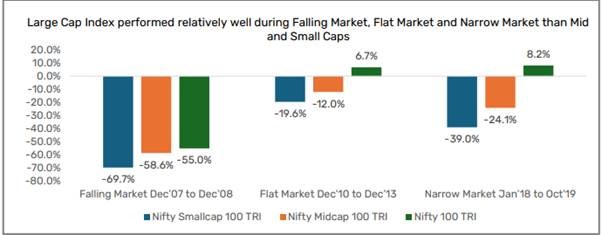Listen to this article
A study by Bajaj Finserv Mutual Fund highlights that large caps have done well in 18 out of the last 21 years. The study also shows that the large cap index performed relatively better than mid and small caps during the falling, flat, and narrow market phases.
During the narrow market period from January 2018 to October 2019, the large-cap index generated positive returns of 8.20%. In comparison, small caps and mid caps were negative, generating -39.0% and -24.1%, respectively.
Similarly, from December 2010 to December 2013, when markets were flat, the large cap index generated 6.7% returns while small caps and mid caps generated -19.6% and -12.0%, respectively.
From December 2007 to December 2008, during a market downturn, the large cap index declined by 55.0%. Small caps and mid caps fell much more, by 69.7% and 58.6%, respectively.
Interestingly, when the market turned around, large caps rebounded by 148% and regained their capital by September 2010, taking approximately 1.5 years to recover from their lowest point of the global financial crisis. In contrast, small caps required an additional 5.2 years, fully recouping their capital only by June 2014.

Source: ICRA MFI
In a press release, the fund house said, “Large caps tend to fall lesser than their peers in mid and small cap space and thus recoup their losses much faster when sentiment turns. The current valuation of the large caps is closer to the long-term average of 23.1, indicating that the large caps are in the fair value zone for long-term investors.”
Overall, the Nifty 100 TRI has seen 33x growth in the last 21 years and 17.4% since its inception.
In conclusion, large caps are relatively attractive investments due to their reliable track record. These established companies tend to recover faster from market downturns and deliver relatively better returns even during tough times.




